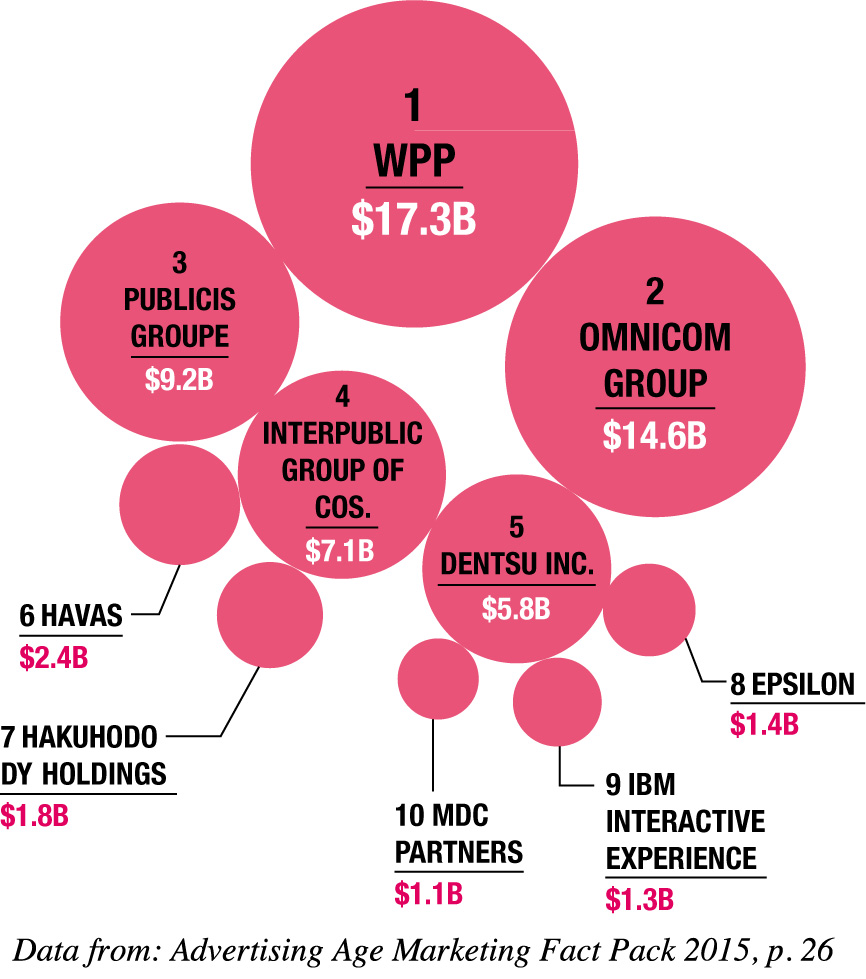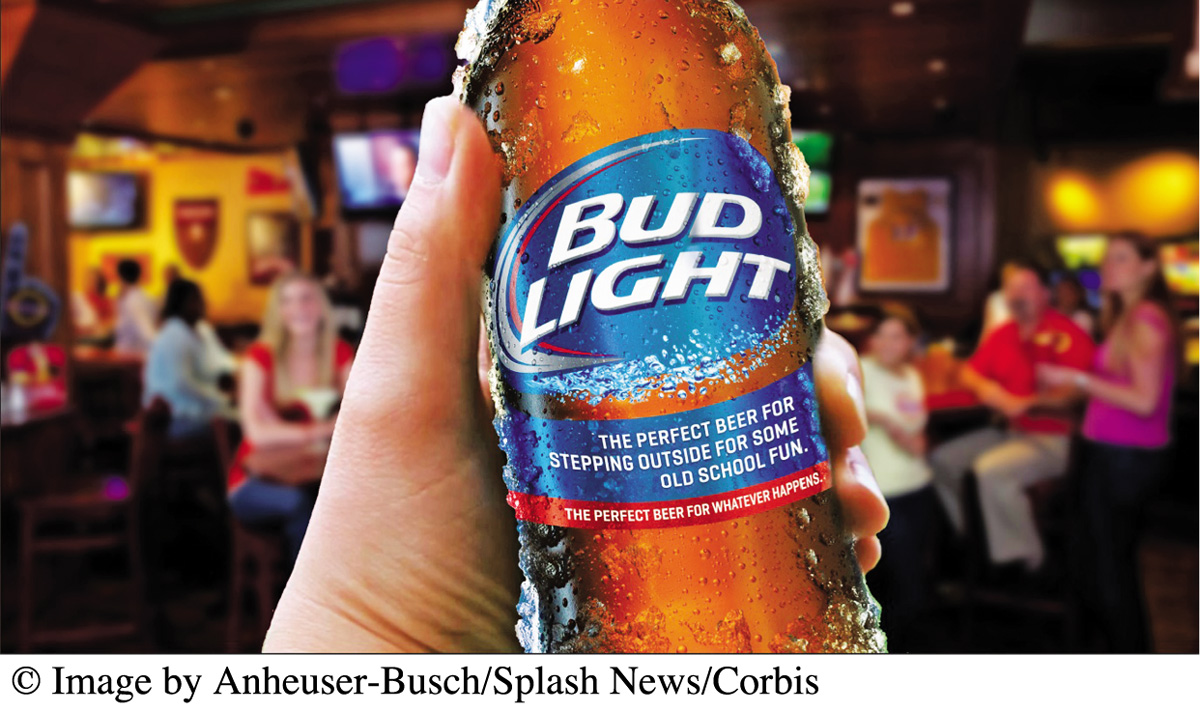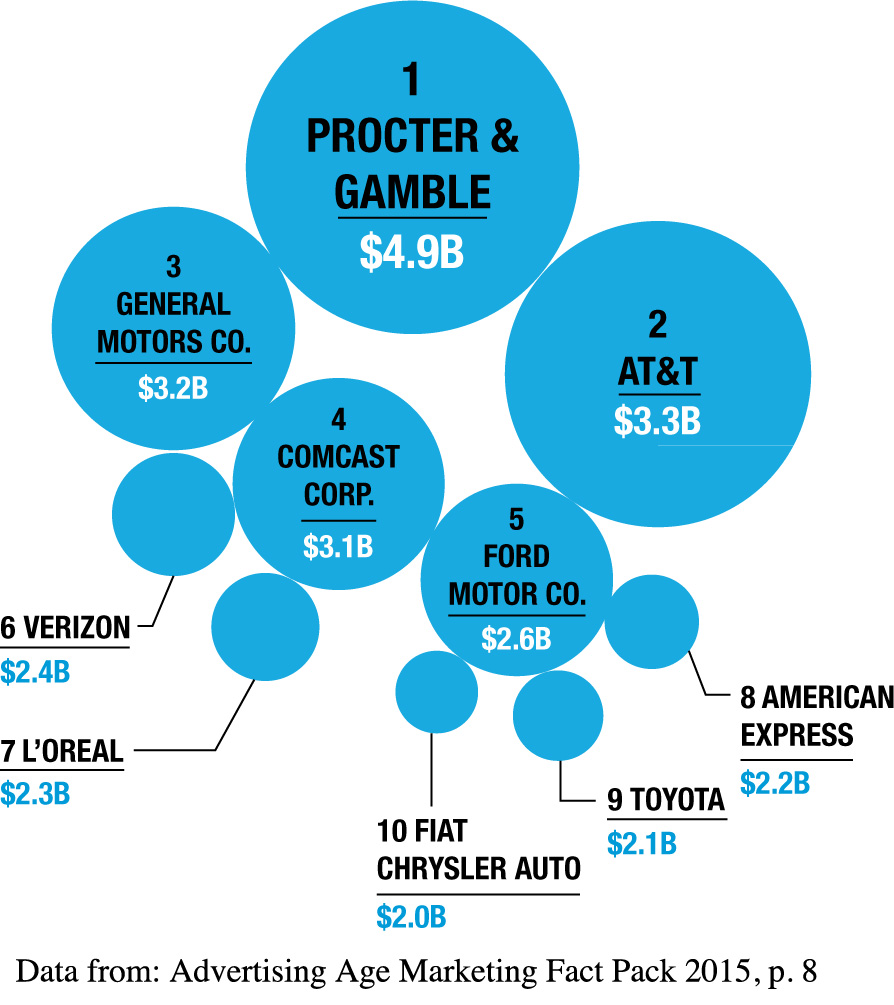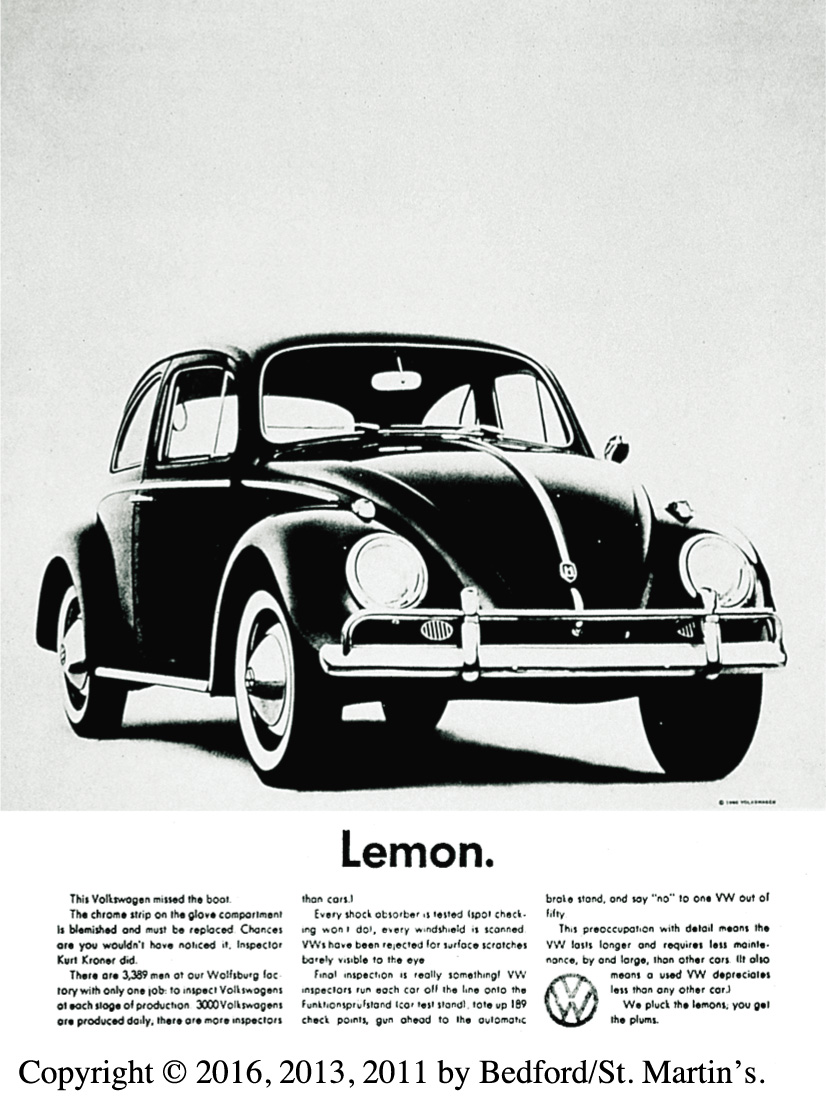The Evolution of U.S. Advertising: 1950s to Today
As the twentieth century progressed, U.S. advertising changed in several ways. Visual design began to play a more prominent role in ads, reflecting people’s growing interest in imagery. This trend helped spark the growth of new types of ad agencies that began dominating the field—large global firms serving a broad range of clients, and small companies working for a select group of clients. Ad agencies of all types developed a distinctive organizational structure, which included specialized departments responsible for such activities as account planning and creative development. But that, too, began changing with the advent of the Internet in the 1990s. The new medium presented fresh possibilities for designing and placing ads, giving rise to entirely new types of players in the advertising sector, including search engine giant Google.
Visual Design Comes to the Fore
Visual design began playing a more central role in advertising during the 1960s and 1970s. This revolution was influenced in part by overseas design schools and European designers—whom agencies hired as art directors and who were not tied to word-driven print and radio advertising. The new emphasis on imagery also drew inspiration from changes in television and cable content. By the early 1970s, agencies had developed teams of writers and visual artists, thus granting equal status to images and words in the creative process. Video-style ads featuring prominent performers (Ray Charles, Michael Jackson, Madonna) soon saturated TV.
Today, thanks to technologies such as mobile phones, tablet computers, and incredibly crisp digital displays, visual design has reached new levels of sophistication. For example, ads on mobile phones feature full-motion 3-D animation and high-quality audio. At the same time, designers have had to simplify the imagery they create, so that ads and logos can show up clearly and scroll vertically on small digital screens. Finally, to appeal to the global audience, many ad agencies are hiring graphic designers who can capture a diversity of visual styles from around the world.
New Breeds of Advertising Agencies Are Born
The increasing prominence of visual design in advertising led to the development of two specialized types of advertising agencies: mega-agencies, large firms that are formed from the merging of several individual agencies and that maintain worldwide regional offices, and boutique agencies, smaller companies that devote their talents to just a handful of select clients. Both types of agencies wield great control over the kinds of advertising we see daily.
Mega-Agencies
Mega-agencies provide a full range of services—from handling advertising and public relations to operating their own in-house radio and TV production studios. The five largest mega-agencies are WPP, Omnicom Group, Publicis Groupe, the Interpublic Group of Companies, and Dentsu, with a combined revenue in 2013 of about $54 billion.2 In 2013, Omnicom and Publicis announced plans to merge, which might have made them the biggest ad agency, but the deal fell apart in 2014 and the merger was called off (see Figure 11.1).

The mega-agency trend has stirred debate among consumer and media watchdog groups. Some have considered large agencies a threat to the independence of smaller firms, which were slowly bought up in the 1990s. Others warn against having a few firms control much of the distribution of advertising dollars globally. According to these critics, with such concentration of power, the cultural values depicted in U.S. and European ads (such as an obsession with youth or appearance) could unduly influence people in developing countries or regions with markedly different values. Such critics decry the intrusion of American culture into these areas.
Boutique Agencies
The visual revolutions in advertising during the 1960s elevated the standing of the creative side of the ad business, particularly the designers, writers, and graphic artists who became closely identified with the look of specific ads. Breaking away from bigger agencies, many of these individuals formed small boutique agencies. Offering more personal services, the boutiques prospered—thanks to the innovative ad campaigns they developed to popularize brands like Nike, ESPN, and Target.
Throughout the 1980s and 1990s, large agencies bought up many of the boutiques. Nevertheless, some boutiques continue to operate as fairly independent subsidiaries of multinational corporations. Due to the economic crisis, both types of ad agencies suffered revenue declines in 2008 and 2009 but slowly improved in 2010 and 2011.
Ad Agencies Develop a Distinctive Structure
Regardless of type (mega or boutique), most ad agencies have a similar organizational structure, comprising four main functions: account planning, creative development, media buying, and account management.
Account Planning
The account planner’s role is to develop an effective advertising strategy by combining the views of the client, creative team, and consumers. Consumers’ views are the most difficult to understand, so account planners coordinate market research to assess consumers’ behaviors and attitudes regarding particular products long before the agency develops any ads. Researchers might test consumers’ preferences regarding a wide range of things—including possible names for a new product, size of text in a possible print ad, and potential features of a product in development.
Agencies have increasingly employed scientific methods to study consumer behavior. The earliest type of market research, demographics, mainly documented audience members’ age, gender, occupation, ethnicity, education, and income—and then looked for patterns between these characteristics and consumers’ purchasing choices. (For example, what types of clothing and skin-care products do high-earning women over forty years of age generally purchase?) Today, demographic data have become even more specific, enabling marketers to identify consumers’ economic status and geographic location (usually by zip code) and compare their consumption behaviors, lifestyles, and attitudes.
By the 1960s and 1970s, advertisers and agencies began using psychographics, a research approach that attempts to categorize consumers according to their attitudes, beliefs, interests, and motivations. Psychographic analysis often relies on focus groups, a small-group interview technique in which a moderator leads a discussion about a product or an issue, usually with six to twelve participants. For instance, a focus group moderator may ask participants what they think of several possible names for a new brand of beer, why they like or dislike particular names proposed, and what role beer plays in their lives.

In 1978, this research grew even more sophisticated when Strategic Business Insights (formerly SRI International) developed its Values and Lifestyles (VALS) strategy. Using questionnaires, VALS researchers today divide respondents into eight types—thinkers, innovators, achievers, strivers, survivors, believers, makers, experiencers—associated with certain behaviors and preferences of interest to clients. For example, an automaker considering which vehicle models to advertise during which types of TV shows might be told that achievers watch a lot of sports programs and prefer luxury cars, whereas thinkers enjoy TV dramas and documentaries and like minivans and hybrids.
VALS research assumes that not every product suits every consumer, and encourages advertisers to pitch various sales slants to particular market niches. VALS (and similar research techniques) ultimately provides advertisers with microscopic details suggesting which consumers may be most likely to buy which products, but it also stereotypes people as consumers, reduced to eight manageable categories.
Creative Development
Teams of writers and artists—many of whom regard ads as a commercial art form—make up the nerve center of the advertising business. They outline the rough sketches for print and online ads and then develop the words and graphics. For radio, “creatives” prepare a working script, generating ideas for everything from choosing the narrator’s voice to determining background sound effects. For television, they develop a storyboard, a roughly drawn comic-strip version showing each scene in the potential ad. For digital media, the creative team may develop Web sites, interactive tools, games, downloads, social media campaigns, and viral marketing—short videos or other forms of content that they hope will swiftly capture an ever-widening circle of attention as users share the content with friends online or by word of mouth.
Creatives often lock horns with researchers over what will appeal most to consumers and how best to influence target markets. However, both sides acknowledge that they can’t predict with absolute certainty which ads will succeed, especially in a competitive economy in which eight out of ten products introduced to market typically fail. Agencies say ads are at their best if they slowly create and then hold brand-name identities by associating certain products over time with quality and reliability in the minds of consumers. Famous brands like Coca-Cola, Budweiser, Toyota, and Microsoft spend millions of dollars each year just to maintain their brand-name aura. However, some economists believe that much of the money spent on advertising, especially to promote new products, is ultimately wasted, since it just encourages consumers to change from one well-known brand name to another (see Figure 11.2).

Media Buying
An ad agency’s media coordination department is staffed by media planners and media buyers: people who choose and purchase the types of media that are best suited to carry a client’s ads and reach the targeted audience. For instance, a company like Procter & Gamble, always among the world’s top purchasers of advertising, displays its hundreds of major brands—most of them household products like Crest toothpaste, Ivory soap, and Pampers diapers—on TV shows viewed primarily by women, who still do the majority of household cleaning.

Client companies usually pay an ad agency a commission or fee for its work. But they might also add incentive clauses to their contracts with the agency. For example, they may pay a higher fee if sales reach a specific target after an ad is aired—or pay a lower fee if sales fall short of the target. Incentive clauses can sometimes encourage agencies to conduct repetitive saturation advertising, by which they inundate a variety of media with ads aimed at target audiences. The initial Miller Lite beer campaign (“Tastes great, less filling”), which used humor and retired athletes to reach its male audience, ran from 1973 to 1991 and became one of the most successful saturation campaigns in media history.
Of course, such efforts are expensive. And indeed, the cost of advertising—especially on network television—increases each year. The Super Bowl remains the most expensive program for purchasing television advertising, but running a thirty-second ad during a national prime-time TV show can cost from $100,000 to more than $600,000, depending on the program’s popularity and ratings. Cost thus strongly influences where and when media buyers place ads.
Account Management
An agency’s account executives are responsible for bringing in new business. For example, if a potential new client has requested bids for an upcoming ad campaign, the account executive might coordinate the presentation of a proposed campaign, complete with cost estimates. Account executives also manage relationships with established clients, including overseeing project budgets, market research, creative work, and media planning done on their campaigns. Account executives thus function as liaisons between the client firm and the agency’s creative team.
The advertising business is volatile, and account-management departments are especially vulnerable to upheavals. Clients routinely conduct account reviews—assessing an existing ad agency’s campaign or inviting several new agencies to submit new campaign strategies. If clients are dissatisfied, they may switch agencies, something that has occurred more and more frequently since the late 1980s.3
Online and Mobile Advertising Alter the Ad Landscape
When the Internet made its appearance as a new mass medium in the 1990s, it presented a host of new decisions for companies to grapple with—such as what kinds of ads to invest in and where to place them. It also opened the door for new giants (such as Google) to dominate the online-advertising industry. Building on the popularity of smartphones and tablets, mobile advertising is the latest trend in advertising.


Advertising in the Digital Age
This video discusses how ads evolve to overcome resistance to advertising.
Discussion: Do you recall many ads from the last few times you used the Internet? What do you think this might mean for advertisers?
The Rise of Web Advertising
The earliest form of Web advertising showed up in the mid-1990s and featured banner ads, the printlike display ads that load across the top or side of a Web page. Since that time, Web advertising has grown in sophistication. Other formats have emerged, including pop-up ads, pop-under ads, multimedia ads, and—ironically—the classic thirty-second video ad. Internet advertising now also includes classified ads—the most prominent is craigslist—and unsolicited e-mail ads known as spam. In fact, a number of companies have emerged in the past few years, several in India, devoted simply to producing spam ads for various clients.
Today, paid search advertising dominates sites such as Google, Yahoo!, and Bing. These search engines have quietly morphed into online advertising companies, selling sponsored links associated with search terms and distributing online ads to affiliated Web pages.4 This type of advertising is far more precise than the earlier Web ads, enabling companies to reach target customers defined in ever-narrower terms, such as where they live and what key words they use while searching the Web. Some observers claim that clients in the near future will pay only for highly targeted ads and proven results. This targeting is even more precise with mobile advertising, as ads can be tailored not only to what a person has bought in the past but to where that individual is at a particular moment.
Currently, online companies pose a real threat to traditional advertising agencies. Google, as the top search engine, has surpassed the traditional mega-agencies in revenue, earning $59 billion in 2013, with almost all of that coming from advertising. Facebook, the top social networking site, is not yet in Google’s league but remains poised to become a bigger advertising threat, with an audience of over 1.3 billion users worldwide in 2014. Facebook earned $7.8 billion in 2013, most of that also coming from ads.5
How Online Ads Work
Online ads are generally placed by advertising agencies and served to hundreds of client sites by the agencies’ computers. The agencies track ad impressions (how often ads are seen) and click-throughs (how often users land briefly on a site before clicking through to the next site). They also develop consumer profiles that direct targeted advertisements to Web site visitors. Online agencies gather information about Internet users through “cookies” (code that tracks users’ activity on the Web) and online surveys.

Mobile phones and tablets have provided a “third screen” (in addition to TV and personal computers) for online advertisers. These devices present the possibility for advertisers to tailor ads to phone users’ specific geographic location. For example, a restaurant chain can display a special promotional ad on the mobile phone of someone driving a car or walking in the area of its nearest location. Google has also developed unique applications for mobile advertising and search. For example, the Google Goggles smartphone app enables users to take a photo of an object—such as a book cover, a landmark, or a logo—and then have Google return related search results. Google’s Voice Search app lets users speak their search terms. Such apps are designed to maintain Google’s dominant Web search engine position (which generates most of its profits) on the increasingly important mobile platform. Other mobile ad technologies include QR (Quick Response) codes, square bar codes that link to videos and Web pages when scanned by mobile phone cameras. Smartphone cameras can also be used to launch “augmented reality” views (not unlike the effect of the digital “first down” line in football television broadcasts), which can layer advertising and other sorts of information over a camera’s real-time image of a product or shopping district. Google has put that same augmented reality technology into eyeglasses, which have small cameras that “see” what we see, then layer information (and ultimately advertising) in the small screens for each eye. The company rolled out its prototype model in 2013 and made it available to the public in 2014 (with a price tag of about $1,500), but it failed to catch on with the public. Google announced in early 2015 that it was going to quit marketing the glasses for a while so it could develop an updated version.
Advertising Invades Social Media
Social media, such as Facebook, Twitter, and Foursquare, provide a wealth of data for advertisers to mine. These sites and apps create an unprecedented public display of likes, dislikes, locations, and other personal information; advertisers use such information to further refine their ability to send targeted ads. Facebook and other sites like Hulu go even further by asking users if they liked the ad or not. The information users provide goes straight back to advertisers so they can revise their advertising and better engage their viewers. Most social media also encourage advertisers to create their own online identity, with a Facebook page that users can “Like” and share with one another. Despite appearances, such profiles and identities still constitute advertising and serve to promote products to an online audience for virtually no cost.
Companies and organizations also buy traditional paid advertisements on social media sites. A major objective of their paid media is to get earned media, or to convince online consumers to promote products on their own. If you “Like” a particular ad or product on Facebook, your friends may view it, knowing that you like it. Social media are helping advertisers use such personal endorsements to further their own products and marketing messages.
Web Advertising’s Growing Power
The leading Internet companies aggressively expanded into the advertising market by acquiring smaller Internet advertising agencies. For example, in the past few years Google bought DoubleClick, the biggest online ad server, and AdMob, a mobile advertising company. Yahoo! purchased Right Media, which auctions online ad space. Apple purchased Quattro Wireless, a mobile ad company, while Facebook bought Relation, another mobile advertising firm. Amazon.com didn’t purchase an ad agency but partnered with San Francisco–based online advertiser Triggit to sell ads to Amazon users based on their browsing history. This kind of micro-targeted advertising—based on the data mining of browsing or buying history, social media contacts, and other personalized information—is becoming ever more common as mass media (and other aspects of life) converge on the Internet.
With their deep pockets and broad reach, these companies also began to move beyond the multibillion-dollar Internet ad market and have become ad brokers for other mass media. Meanwhile, the traditional advertising agencies have struck back by expanding their Internet capabilities.